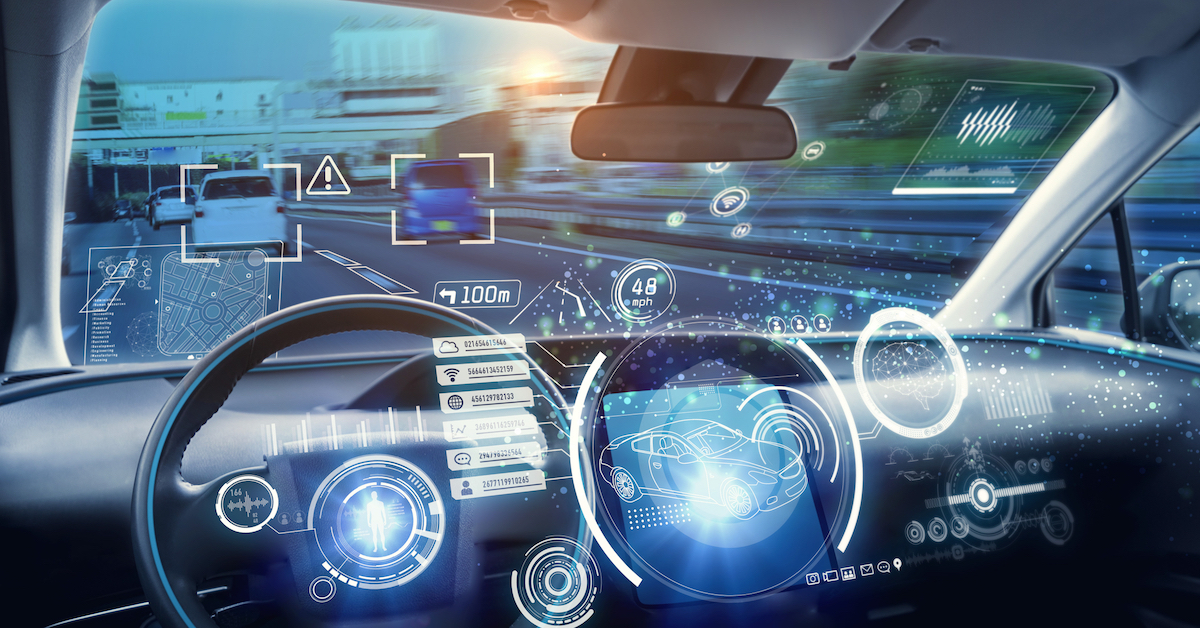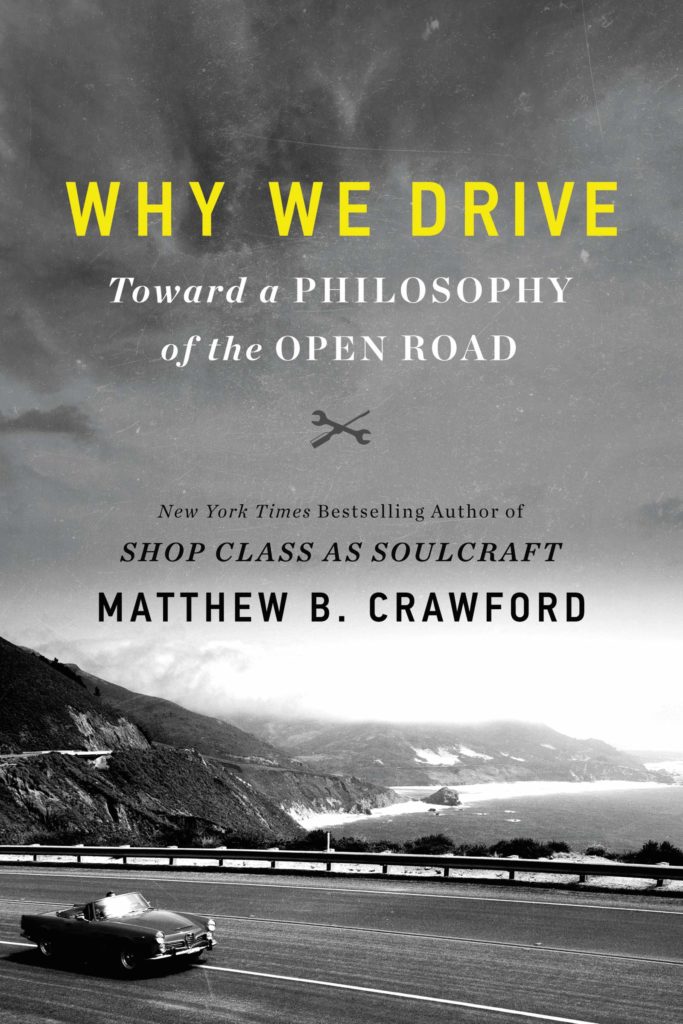Lancaster, SC. For about two decades now, Matthew Crawford has garnered a reputation as a philosopher of the everyday, with a keen interest in securing human flourishing in the digital age. Whether it be his concerns about the technological mindset in education, his defense of the trades and manual competence in Shopclass as Soulcraft, or his suggestions for overcoming distraction in The World Beyond Your Head, FPR is no stranger to his work. It was, of course, about a decade ago when FPR ran a week-long symposium, engaging with his best-selling Shopclass as Soulcraft.
In his June 2020 release, Crawford tackles the emerging world of autonomous vehicles, and comes to some thought-provoking conclusions. As Crawford puts it, “Driverless cars are one instance of a wider shift in our relationship to the physical world, in which the demands of competence give way to a promise of safety and convenience” (5). He continues, “I want to explore this one domain of skill, freedom, and individual responsibility—driving—before it is too late, and make a case for defending it” (7).
Part personal narrative, part philosophical inquiry, Crawford’s book causes readers to carefully consider the far-reaching implications of autonomous vehicles, but even more so, the larger environment in which they have arisen: “a world that is tailored to your data-self through a process that is beyond your reach” (287). In impressive interdisciplinary fashion, Crawford’s Why We Drive lays out a case for not surrendering the steering wheel to technology’s tentacles, one that is particularly compelling for those of us who value human freedom and embodiment.
In a piece for Public Discourse, with help from Crawford’s book, I attempted to unpack how autonomous vehicles might erode human agency and increase passivity, and I suggested some possible connections between human driving and social capital. But here I’d like to explore some other aspects of Crawford’s book, namely what type of relation between humanity and technology Crawford suggests and the dangers of what Crawford terms “safetyism.”
A Free Relation to Technology
Crawford makes clear that “this book is not a cry for ‘the human’ versus technology” (11). Instead we should strive for a “fully free relationship to technology,” which Crawford sees as “one that neither shuns it as an alienating magic nor accepts uncritically the agenda that is sealed inside the black box” (129). In this sense, Crawford is certainly not anti-technology. Rather, his concern is that digital technology is so intertwined with everyday practice that it is absorbed as normal, subtly influencing what we think about ourselves and the world.
Long before the digital revolution, in The Question Concerning Technology, Heidegger voiced similar concern that a technological view of mind and being “threatens to sweep man away into…the surrender of his free essence” (314). This concern gathers importance as it becomes ever more difficult to extract oneself from the increasing integration of everyday existence with digital technologies. “The more ‘seamlessly’ it all works together,” Crawford notes, “the higher the cost of wrenching yourself free of the whole apparatus, if doing so is even an option” (298).
Crawford sees this coming to fruition in the realm of autonomous vehicles, as freedoms are bartered away for convenience in a bargain facilitated by the eager hands of hidden Big Tech bureaucracies and political administration. “As we contemplate turning mobility over to a cartel of tech firms who seek to make everything interconnected,” Crawford pauses to ask, “Do we want to make getting from point A to point B something you do, not in a car, but in a device, that is, a portal to overlapping bureaucracies? Do we want to make the basic animal freedom of moving your body through space contingent on the competence of large organizations?” (298).
These are serious questions to grapple with if we are to maintain the free relation to technology so vital in maintaining human persons and communities. Such freedom begins with understanding that technology is not inevitable and not neutral—what I call healthy technological skepticism. Neil Postman put it this way: we should maintain “an epistemological and psychic distance from any technology, so that it always appears somewhat strange, never inevitable, never natural” (185).
Yet such a free relation to technology is at odds with the pervasive progress narrative used by tech giants, pop-culture icons, or politicians who, Crawford says, “generate a feeling of inevitability around some desired outcome” (42). Crawford turns the screws further in relation to autonomous vehicles: “Driverless cars are going to happen in a big way, we are told, because it has been decided—by something called ‘the future’” (42).
Crawford poignantly suggests that, contrary to the progressive narrative of change, much historical progress has actually been made by embracing tradition. He states, “Tradition itself can be an engine of progress. It organizes the transmission of knowledge. It also provides an idiom for some shared endeavor, and a set of historical benchmarks” that can sometimes bring “a whole community to new and unexpected places” (136). Echoing Michael Oakeshott, Crawford suggests such a valuing of tradition is best understood not as “hankering after the past nor fear of the future, but rather affection for the present. One cherishes what actually exists, because one sees the value in it” (82).
Affection for the present, or what could rightly be called gratitude, is an orientation to the world that can help sustain human flourishing. However, when tasks in-the-world are further automated by technological devices, opportunities for such affection and gratitude diminish, as does our natural, “animal genius for learning about the world by acting directly on it” (127). Crawford goes further, arguing that, “In response, we may become dispirited in the way an animal does when it is removed from its accustomed habitat, the one that calls forth its full repertoire of excellences. In this dispirited state, we do in fact become incompetent” (127).
Safety and “Safetyism”
As pacified lab-rats or zoo-animals pale in comparison to their wild counterparts, so too humans need a “natural world, with its problems to solve” to fully express their human capacities (64). But the narrative of progress and the repeated claims of autonomous vehicle safety make even questioning driverless cars difficult. This is where Crawford digs in, contending that while car safety has improved drastically since the mid-1900s, there is a difference in recent assistive technologies compared to previous mechanical improvements. As driving automates—courtesy of features like brake-assist or lane-keeping—the common challenges for pilots of highly automated planes are beginning to appear among drivers. Most notably with primary-secondary task inversion, which atrophies actual driving skill and replaces it with listening for alarms (97-101).
The FAA explains: “Instead of monitoring altitude, pilots sometimes simply listen for the alert. This phenomenon is one instance of what human factors experts call primary-secondary task inversion: when an alert or alarm designed as a secondary backup becomes the primary source of information. In the case of the altitude alerting system, when the alerting system is missed, or you are distracted, nothing is left to prevent an altitude deviation.”
Crawford translates for cars: “When the driver is out of the loop of controlling their vehicle, they tend to become sleepy and less vigilant, and it takes them longer to respond to sudden events . . . [and] more likely to panic when overstimulated, as happens when dealing with a failure of the automation” (101-104).
Ironically, despite safety claims made on behalf of autonomous vehicles, autonomous car crashes in recent years have revealed the ongoing limitations of fully driverless technologies. Also, a June 2020 study suggested that two-thirds of the crashes they examined would still have occurred even if all cars were fully autonomous. Furthermore, the types of crashes autonomous vehicles tend to be in reveal the inherent weaknesses of machine driving when it comes to social awareness and mutual prediction. California’s 2018 autonomous vehicle collision reports show almost two-thirds of the accidents were autonomous vehicles being rear-ended. At first glance, this could be further justification for getting rid of human drivers. But Wired author Jack Stewart explains that we “have reason to believe that the autonomous vehicles are doing something that makes cars behind them more likely to hit them. Maybe that’s driving herkily-jerkily . . . or stopping for no clear reason. . . . part of being a good driver is behaving in a way others expect, which doesn’t include constantly stamping on the brakes.”
Driverless advocates suggest these glitches will be remedied in future tech iterations, and that solving the challenge of interfacing human drivers with autonomous vehicles is ultimately found in eliminating the human variables. As Crawford puts it, “Automation has a kind of totalizing logic to it. At each stage, remaining pockets of human judgment and discretion appear as bugs that need to be solved” (104). But the point raised throughout this essay and throughout Crawford’s book is that such a utilitarian calculus overlooks the deeper issues at play.
Crawford then goes beyond dissecting automaker safety claims to criticizing the broader cultural concept of what he calls “safetyism.” While “safety is obviously very important . . . it is also a principle that, absent countervailing considerations, admits no limits to its expanding dominion. It tends to swallow everything before it” (33). Safetyism is risk-reduction at all costs, and it creates “a society based on an unrealistically low view of human capacities. Infantilization slips in, under cover of democratic ideals” (34).
Such risk-aversion and fear of failure expands “in the affluent West, [where] many of our energies of innovation seem to be channeled into creating experiences for the consumer that will make him feel good without making demands on him” (114). Crawford calls these manufactured experiences, which “are offered as a substitute for direct confrontation with the world . . . [and] allow us to remain cocooned in a fantasy of competence and empowerment” (114). Safe, insulated existence may seem satisfying, but measured risk is part of being fully alive, part of what makes us human.
Crawford’s exposure of “safetyism” has applications far beyond the push for driverless cars. From the infamous “safety moments” at countless workplace meetings that function as invocations to appease the gods of safety, to helicopter parenting and the resulting burnt out kids, we are seeing safety absolutized. I might also suggest, at risk of stepping on toes, that perhaps some of the extreme COVID-19 safety measures are another manifestation of “safetyism.”
Conclusion
Much like Crawford’s other books, Why We Drive is a pleasure to read. His personal stories and snapshots of automotive subcultures woven into the book are alone worth the purchase price. The stories, coupled with his main argument, make a compelling case for the practice of human driving. Crawford’s skepticism of autonomous vehicles is both practical and principled. He practically dissects the safety claims of driverless advocates, yet he also challenges the underlying assumptions about humanity and the world latent in autonomous vehicle technology. The book also offers several other lines of thought to explore, much more than can be dealt with here.
After reading the book, I found myself ruminating about the book’s ideas while driving. Just a few days ago, while navigating Charlotte traffic in my manual transmission F-150, I encountered an interesting hand gesture in my rearview mirror, while off the line at a stoplight. This happens sometimes, as manuals have a different acceleration pattern than automatics. At stoplights this requires a closer eye on the car behind, anticipating when best to shift where space can accommodate that distinctive lull in acceleration. While it might be nice not to have to do so, I think such awareness and responsiveness is a small glimpse of what Crawford is getting at in Why We Drive.
Human driving requires unending mutual predictions and constant accommodations for each other. Yes, sometimes it fails tragically, with accidents, road rage and traffic jams. But most of the time, it works. And it is here in this accumulation of the everyday experience of driving that we end up with something meaningful for life in the physical world and life in community.
At the next stoplight, I thought to myself, for each close call or road rage clash we remember, how many ordinary, successful driving experiences do we forget? For the lead foots, how many cars did you go by without a hitch? For the slowpokes, how many cars went by you without a worry? As the light then turned green, I noticed that the driver who was quite accomplished with his sign language had provided me a bit more space this time. Charity and cooperation? Maybe. Begrudging acknowledgement of the other? Probably. And that is at least a place to start.








6 comments
Josh Pauling
Hi Aaron,
Thanks for the comment. Yes, I find OWWM a great resource, and actually wrote about the allure of vintage machinery for FPR over the summer: https://www.frontporchrepublic.com/2020/07/the-allure-of-old-tools-and-vintage-machinery-memory-meaning-and-making/
My machinery restorations can be found here: https://www.youtube.com/channel/UCo8Roy6sm0eMYRGKW1-0yNA
My furniture can be found here: https://sites.google.com/site/daddysworkshopofthecarolinas/
Best,
Josh
Aaron
Thanks, Josh. I missed that article, since over the summer when I’ve not teaching, I’m usually buried in my shop, building furniture, so you beat me to the punch.
That’s a nice looking PM160. I’ve got a 180 of the same vintage. Have you got the overhead knife grinder for it? Probably my favorite restoration is a tank of a Clement 16″ jointer I did.
I’ll check out your furniture. I’ll bet I’ll get a few ideas. 🙂
Aaron
Josh Pauling
Aaron,
I don’t have the grinder bar for the pm160. Sounds like you’ve got an awesome shop! I always appreciate your writings here – looking forward to your next piece.
Josh
Steven H
Great review. I’m downloading the audio version, not because I don’t appreciate the “psychic distance” that a tactile book in hand offers but because I think that is how the book was conceived. While doing something else, like working on motorcycles, ideas flowed out that flow in, for me, while cultivating diakon radishes. Crawford is humble and yet, in my opinion, the best observer of the real forces of change in our time. He sees the sign and not signal. Media, not message, is the logic of our Technological Society.
Josh Pauling
Thanks Steven! I agree with your evaluation of Crawford–one of the clearest voices in supporting human flourishing in a digital age.
Best,
Josh
Aaron
Josh:
Read your bio: So are you an OWWM’er, then?
I’ve been thinking of writing something for FPR, about that.
Aaron
Comments are closed.